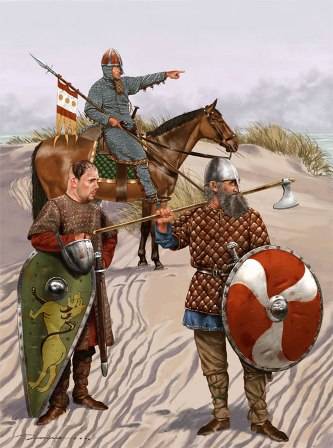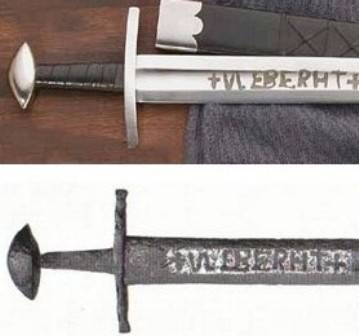VIKING SWORDS
Romantic legend and tradition has left us with an image of the Vikings as a group of Northern barbarians that practiced piracy and spread their fury throughout Europe. They are displayed as hordes of blood-thristy warriors crowned with horned helmets, sword in hand, moving around in their characteristic boats, willing to destroy anything that crossed their path. Nevertheless, this vision of Viking life is not without topics that history and the passing of time have helped to consolidate. Today, thanks to historical studies based essentially on archealogical sources, that take cultural material as reference (swords, shields and jewellery...), a great part of the history of these Northern tribes has been unravelled, and it has been discovered that they were in fact fascinating people.

Viking sword with the typical short guard (the part that protects the handle).
Vikings are known as the inhabitants of the present Sweden, Norway and Denmark. Inhabitants of these lands shared common features such as language, religion, customs and character, something that made them a common ethnic reality defined as the Scandinavian people. The domination of the so-called Viking Age began at the end of the eight century AD with the looting of the Lindisfarne Monastery on the East coast of England and continued to spread for the next three hundred years. This time was a period of constant stuggles to survive, but also became an era of great discoveries and adventures.
The word 'Viking' could have been derived from the Nordic term vik, whose significance is creek or small bay, which could refer to the fact that they would settle in bays. It is also possible that it is derived from the wordViken, a term which is refers to the Norwegian fjords. Nevertheless, in spite of that fact that nowadays this term 'Vikings' has been generalised and is commonly accpeted, the sources of the Middle Ages show that they were referred at that time as Magus (infidels), Gall (foreigners) or as far as the Oriental and Arabic sources are concerned, they were called the Rus, a term which seems to have been derived from the Swiss word Ruotsi (rowers).
The Vikings enjoyed superiority in the sea, above all due to the egineering of their boats. With their ships they began to expand, not only in Europe but they also arrived as far as the Orient and to what we now know as North America. In their expanision they seeked above all to expand trade with the opening of new markets and the acquisition of new lands to exploit agriculturally; which was all to increase their power and wealth.

The Vikings extended their territory throughout Eastern and Southern Europe.
In the beginning of their territorial expansion the Vikings arrived first to England, Scotland and Ireland, the area where they founded the settlement Dyfflin, today known as Dublin. They continued their adventure landing in France where they settled along the lower course of the river Seine. It was then that the King of France signed a treaty with Rollo, the Viking chief, giving them the territory of Nostri, subsequently known as Normandy. The Vikings also made their way to Southern Europe, with presence in the Italian and the Iberian Peninsula.
On the east, along the river courses, they succeed in crossing the Russian steppes where they founded a new kingdom. They also made their way up the East by establishing long-distance trade routes between northern Europe and eastern lands. In the East they achieved to sieze Constantinople, the capital of the Byzantine Empire, and they established trade relations with the city of Baghdad.
In the west they reached as far as Iceland, which was only inhabited by a number of Irish hermits before the Viking arrival in the early ninth century AD. From there, a group of Vikings led by Erik the Red came to land in what is now known as Greenland. But the Viking's westward expanision did not end there, their discoveries continued, converting their people into the first "discoverers" of American territories, five hundred years before the arrival of Columbus. It would be the son of Erik the Red, accompanied by thirty or so Vikings, who at the end of the tenth century AD who would arrive at the Labrador Peninsula and go down the American East Coast.

Landing of Viking warriors armed with axes, shields, spears and swords.
The Vikings have passed through history as exceptional warriors of great courage, even Christian sources reflect the admiration felt for the strength and courage that the Scandinavians showed in combat. It must be said that the Viking people were not only a warrior people as, like the rest of the population living in Europe at that time, many of its people were engaged in agriculture and livestock in order to survive. The increasing population and the lack of land forced them to look to new territories. Moreover, the Vikings were outstanding sailors, something that led them to sea on many occasions in search of new horizons and more riches, be it either by looting, or through the collection of taxes and trade.
Some people called the Vikings "The Curse of the Dark Ages", as they spread east and west showing the great severity that has earned them their reputation. Certainly the Vikings, as indicated, were very brave warriors and for them war was an honorable activity. So much so that according to religious Viking tradition, the soldiers who died with a sword in their hand had a guaranteed place in Valhalla, a type of heavenly paradise. The Vikings extended their power through war, which they carried out with their swords and axes.

'Sverd i fjell' or 'Swords in Rock' monument, with three 10 metre long Viking swords commemorating the unification of Norway under Harald I in the ninth century.
The Viking soldier would prepare himself for battle by covering his body in leather or chain mail. In turn, he would cover his head with a cone shaped metal helmet that would usually have metal or leather protectors for the nose and the cheeks. It is interesting to note that when we tend to imagine a Viking warrior with a helmet adorned with two horns on the sides, this is an image that is in fact far from reality, as the Vikings did not wear horned helmets. As the last, defensive weapon of a Viking warrior he would carry a circular shield that was made of wood and used to be covered with iron sheets.
Out of the offensive weapons that the Vikings used, four stand out in particular. The first of them is a long-handled axe, a fierceandeffective weapon, used mainly by the more humble warriors as the axes were always cheaper than the viking swords. Nevertheless, the efficiency of the axe was indisputable as it could kill a horse, split a shield in two or cut an enemy only with one stroke. Another essential weapon was the bow and arrow with which the Vikings used to begin their battles. They were bows of medium length, made nearly always out of yew wood and reinforced by leather. The bowstrings, as weare told in Viking tales, were made from braided women's hair. Another frequently used offensive weapon, above all by the free men (farmers without socail status) was the spear. The spear consisted of a handle of approximately two metres that ended in an elongated steel point of about twenty centimetres.

Historical Viking swords found in archaelogical sites.
Last, but by no means least, the Viking sword was one of the most popular weapons used during the Viking Age. The Viking sword was a very effective weapon in the battle field; this has been demonstrated thanks to recent studies of the remains from the conflicts found in Northern lands such as those from the battle of Visby in Sweden. Skulls have been found in this area which show that more than half of those who died at the hands of the Vikings did so after receiving a single, clean cut on the head with a sword.
So the Viking sword was designed to cut, thanks to its double-edged blade, and not so much for stabbing. This is confirmed by the fact that the equilibrium point of the sword is placed at quite a distance from the hand guard, towards the tip, which helped to boost energy and strength of the blows, but hindered the recovery of the weapon after a strike. This sword was designed to be operated with one hand, because the handle was very short, and with the other hand the Vikings would hold a shield. The Viking sword was topped off with a handle that would usually have lobed or triangular forms at the end that were often hollow.

Equipment that a Viking warrior would use: sword, axe, spear, helmet, chain mail and shield.
Viking swords evolved towards new models, adapting to the changing war strategies, developing small changes in form over the three centuries of the development of the Viking civilization. Some authors understand that the Viking sword as an evolution of something between the Roman gladium or spatha up until Medieval times, when it developed into the traditional medieval sword. Authors such as R. E. Oakeshott, in the 60s, or J. Petersen, at the beginning of the last century, haveresearched and investigated thoroughly Viking swords and have developed lists of types which provide proof of the development of Viking swords on the basis of distinguishing features between them.
This series of features that changed progressively can be summarised generally in the following characteristics: the Viking sword blade got longer and longer as the years passed and therefore the weight also increased (although the weight never passed one and a half kilos). Over time the blade also got wider towards the hilt and tapered more towards the tip of the blade. In addition, the tip was made progressively more obtuse, reinforcing the utility of the Viking sword for chopping rather than stabbing. The crossguard of the Viking sword got shorter and narrower. A feature that did not change was the groove of the blade, on both sides.
It is not strange to find Viking swords with one face of the blade decorated and the end closest to the handle. The most popular decorative motifs were runic symbols or writing. Runes writing was used by all the Germanic peoples and it had its moment of greatest glory between IX and XI AD. On some occasions, the name of the craftsman who made the sword could be found engraved on the sword too.

Viking swords with the Ulfberth signature. Some theories have pointed out that this signature could have referred to a metal workshop that made this type of sword.
It is worth mentioning one of the most important revolutions of the Viking swords that displays the basic features that would eventually lead to the Medieval sword. It is a Norman sword, developed during the X to the XII century AD. This sword demonstrates a narrower and longer blade than the Viking sword. Moreover, the sharp edge becomes sharper, not so blunt, allowing it to be used both to cut and to the stab. It also has a wider guard to protect the hand wielding the sword.
We can conclude by saying that the Viking sword was the favourite weapon of the Scandinavian warriors, so much so that the Vikings trusted their lives to this bellicose object, as mentioned by Esaias Tegner's poem of the nineteenth century, entitled The Saga of Frithiof, referring to the status of the Viking: "Make no tent on thy ship, never sleep in a house, for a foe within doors you may view; On this shield sleeps the viking; his sword in his hand, and his tent is the heavenly blue".

Norman sword is an evolution of the Viking sword.
 Cookie preferences
Cookie preferences
 WhatsApp
WhatsApp
 Call us
Call us
 FAQs
FAQs